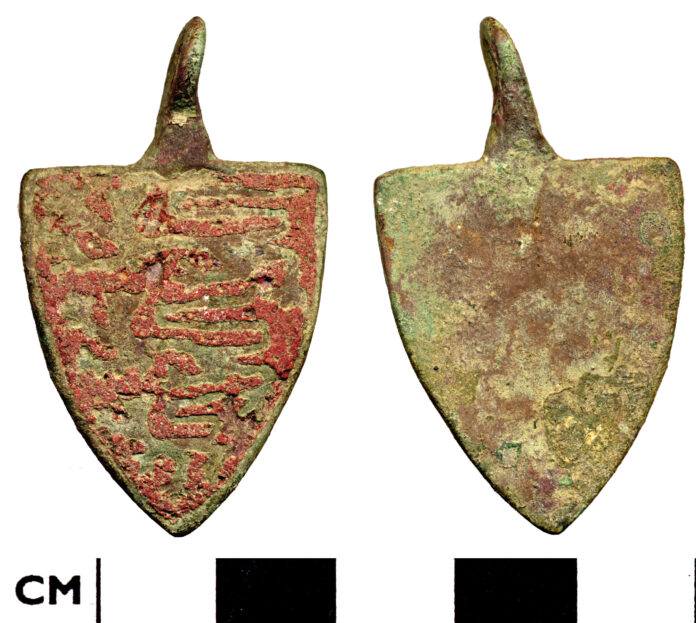Medieval Treasure Unveiled: The 800-Year-Old Three Lions Pendant Found in Warwickshire

The Discovery of a Priceless Treasure

Archaeologists working on the HS2 project discovered the pendant in the village of Wormleighton, Warwickshire, located about 50 miles southeast of Birmingham. Dating back to the 12th century, the pendant is believed to have once adorned a horse harness. Its shield-shaped design, known as a “heater” shield, features three golden lions on a field of red, mirroring the England football crest that is so well-known today. The discovery is not only a significant archaeological find but also a symbol that resonates deeply with England’s national identity.
The Historical Significance of the Three Lions
The use of lions as a symbol of England has a storied history, tracing back to William the Conqueror, the first Norman king, who reigned from 1066 until 1087. William introduced two lions on a red background as his coat of arms, a symbol he brought to the English throne. Henry II, who ruled England from 1154 to 1189, added a third lion to the emblem following his marriage to Eleanor of Aquitaine in 1152. The three lions became a defining symbol of the English monarchy, particularly during the reign of Henry’s son, Richard I (1189-1199), and continued to represent the Arms of England until the establishment of the Lancastrian Dynasty in 1399.
The Remarkable Condition of the Pendant

The pendant, made of copper alloy, likely brass, was gilded with a thin layer of gold and features three lions etched onto a red background, possibly symbolizing the blood of a battlefield. Despite the passage of centuries, the pendant remains in a “remarkable” state of preservation, with some weathering of the red enamel and gilding evident, likely from its use on a horse harness. Measuring less than 2cm in width and over 4cm in height, the pendant’s small size belies its historical significance.
Archaeology and the HS2 Project
The HS2 project, while controversial for its impact on historic sites and natural landscapes, has provided unprecedented opportunities for archaeological discoveries across Britain. The site where the pendant was found is believed to have been an Iron Age or Romano-British settlement, adding another layer of historical intrigue to the find. The HS2 archaeology program has previously uncovered multiple significant artifacts, including a skeleton with a spear embedded in its back at an Anglo-Saxon burial ground near Wendover, Buckinghamshire.
A Symbol of Inspiration for the Lionesses

The discovery of the pendant was announced just days before the England Women’s football team, known as the Lionesses, competed in the Euro final against Germany. The timing of the find has been seen as a fortuitous omen, with the pendant’s iconic three lions symbol serving as a source of inspiration for the team. A spokeswoman for HS2 Ltd expressed hope that this remarkable piece of history would inspire the Lionesses to create their own legacy on the football field.
Conclusion
The unearthing of the 800-year-old pendant in Warwickshire is more than just an archaeological triumph; it is a connection to England’s rich history and cultural heritage. As the HS2 project continues to unearth secrets from Britain’s past, discoveries like this pendant remind us of the deep roots that national symbols like the three lions have in the story of England. As the Lionesses took to the field, this ancient treasure stood as a symbol of inspiration, bridging the past with the present in a powerful testament to the enduring spirit of England.
Video
News
The Hanging Temple: China’s 1,500-Year-Old Cliffside Marvel of Faith and Engineering
The Hanging Temple: China’s 1,500-Year-Old Cliffside Marvel of Faith and Engineering Perched precariously on the cliffs of Mount Heng in Shanxi Province, China, the Hanging Temple, also known as Xuankong Temple, Hengshan Hanging Temple, or Hanging Monastery, is an architectural…
The Willendorf Venus: A 30,000-Year-Old Masterpiece Reveals Astonishing Secrets
The Willendorf Venus: A 30,000-Year-Old Masterpiece Reveals Astonishing Secrets The “Willendorf Venus” stands as one of the most revered archaeological treasures from the Upper Paleolithic era. Discovered in 1908 by scientist Johann Veran near Willendorf, Austria, this small yet profound…
Unveiling the Maya: Hallucinogens and Rituals Beneath the Yucatán Ball Courts
Unveiling the Maya: Hallucinogens and Rituals Beneath the Yucatán Ball Courts New archaeological research has uncovered intriguing insights into the ritual practices of the ancient Maya civilization. The focus of this study is a ceremonial offering found beneath the sediment…
Uncovering the Oldest Agricultural Machine: The Threshing Sledge’s Neolithic Origins
Uncovering the Oldest Agricultural Machine: The Threshing Sledge’s Neolithic Origins The history of agricultural innovation is a fascinating journey that spans thousands of years, and one of the earliest known agricultural machines is the threshing sledge. Recently, a groundbreaking study…
Nara’s Ancient Sword: A 1,600-Year-Old Protector Against Evil Spirits
Nara’s Ancient Sword: A 1,600-Year-Old Protector Against Evil Spirits In a remarkable discovery that has captured the attention of archaeologists and historians alike, a 7.5-foot-long iron sword was unearthed from a 1,600-year-old burial mound in Nara, Japan. This oversized weapon,…
The Inflatable Plane, Dropped Behind the Lines for Downed Pilots
Experimental The Inflatable Plane, Dropped Behind the Lines for Downed Pilots The Inflatoplane from Goodyear was an unconventional aircraft developed by the Goodyear Aircraft Company, a branch of the renowned Goodyear Tire and Rubber Company, also famed for the Goodyear…
End of content
No more pages to load











